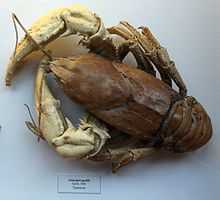Tasmanian giant freshwater crayfish
| Astacopsis gouldi | |
|---|---|
 | |
| Dry museum specimen | |
| Conservation status | |
| Scientific classification | |
| Kingdom: | Animalia |
| Phylum: | Arthropoda |
| Subphylum: | Crustacea |
| Class: | Malacostraca |
| Order: | Decapoda |
| Family: | Parastacidae |
| Genus: | Astacopsis |
| Species: | A. gouldi |
| Binomial name | |
| Astacopsis gouldi (Clark, 1936) | |
The Tasmanian giant freshwater crayfish (Astacopsis gouldi), also called Tasmanian giant freshwater lobster, is the largest freshwater invertebrate in the world. The species is only found in Tasmania (an Australian island), and is listed as an endangered species due to habitat loss and over fishing. It is also severely threatened by siltation and de-snagging of streams as decaying wood forms the favourite part of its diet. It is not known if the animals are nourished by the wood, the bacteria, algae or invertebrates living in the rotting logs. They also eat leaves, fish and other meat, including other freshwater invertebrates.
Individuals of over 5 kilograms (11 lb) in weight and over 80 centimetres (31 in) long have been known in the past, but now, even individuals over 2 kilograms (4.4 lb) are rare.[1] The species is only found in Tasmanian rivers flowing north into the Bass Strait below 400 metres (1,300 ft) above sea level, and is listed as an endangered species on the IUCN Red List.[2] The specific epithet gouldi commemorates the Australian naturalist John Gould.
A. gouldi is very long-lived, surviving for up to 40 years. Their main predators are humans, platypus, river blackfish and rakali.
Biology
Astacopsis gouldi is territorial. Males maintain a harem of several females. Hatchlings are a mere 6 mm long, and mature extremely slowly, living for up to 40 years.[3] Reproductive maturity occurs at around nine years in males and 14 years in females, with females breeding just once every two years. [4] Mating occurs in autumn and the eggs, attached to the female’s swimming legs during development, hatch the following summer, remaining attached to the swimming legs as hatchlings for another month. Such a long reproductive process means that females spend much of their life with their young attached to their legs – a good strategy as fully grown adults have no natural predators.[4] However, fishing of adult crayfish by humans results in the removal of not only the adults but all their young as well.[5]
The giant freshwater crayfish is omnivorous, eating primarily rotting wood and animal flesh, as well as leaves and insects that fall into the water. Juveniles tend to hide in shallow water where they are less at risk from their large predators including other crayfish, fish, and platypus. Adults hide under submerged logs in deep pools where they appear to tolerate each other, despite being aggressive elsewhere.[3]
Habitat and range
These crustaceans inhabit dark, slow-moving rivers and streams with high water quality and little suspended sediment, as well as still, deep pools with logs and overhanging banks to shelter beneath.[4][5][6] The water needs to be below 18°C with high oxygen content.[3]
The giant freshwater crayfish was previously found in all rivers that flow into the Bass Strait, which runs between Tasmania and the Australian mainland. Today, however, the distribution is patchy and limited to less disturbed areas.[5]
Threats and Conservation
The major threat to this species has been over-fishing, since these crayfish are a popular food dish, but this has not been sustainable due to extremely slow maturation and infrequent breeding.[3] Habitat loss is also a threat, as a result of increasing agricultural expansion, forestry operations and changes in water quality.[5] In-stream barriers have reduced the dispersal potential of the crayfish and erosion following agricultural expansion has caused silty water, which is less favourable for the giant freshwater crayfish.[6]
The decline of giant freshwater crayfish numbers resulted in a fishing ban in January 1998, although an ongoing commitment is needed in order for the crayfish to recover from its endangered status. Population surveys and behavioural research are being undertaken in order to be able to provide better habitat protection and improved management of riverbank vegetation.[5]
This species was listed as "vulnerable" under Australian law in 1995, and it is now illegal to catch A. gouldi without a permit, carrying a maximum fine of A$10,000.
References
This article incorporates text from the ARKive fact-file "Tasmanian giant freshwater crayfish" under the Creative Commons Attribution-ShareAlike 3.0 Unported License and the GFDL. [7]
- ↑ "Tasmanian Giant Freshwater Lobster (Astacopsis gouldi)". Department of the Environment, Water, Heritage and the Arts. February 9, 2007. Retrieved March 16, 2010.
- ↑ T. Walsh & N. Doran (2010). "Astacopsis gouldi". IUCN Red List of Threatened Species. Version 3.1. International Union for Conservation of Nature. Retrieved October 5, 2010.
- ↑ 3.0 3.1 3.2 3.3 "The Giant Tasmanian Freshwater Lobster". Retrieved September 2004.
- ↑ 4.0 4.1 4.2 "ADW: Astacopsis gouldi: Information". Animal Diversity Web. University of Michigan Museum of Zoology. Retrieved 11 October 2011.
- ↑ 5.0 5.1 5.2 5.3 5.4 "Threatened species and ecological communities publications - Biodiversity". Australian Government – Department of the Environment and Heritage. Retrieved 11 October 2011.
- ↑ 6.0 6.1 "(Factsheet)". Inland Fisheries Service. Retrieved September 2004.
- ↑ Hamr Premek. 1997. A Giant's Tale: the life history of Astacopsis gouldi (Decapoda: Parastacidae) a freshwater crayfish from Tasmania. Freshwater Crayfish 11 pp. 13-33.
